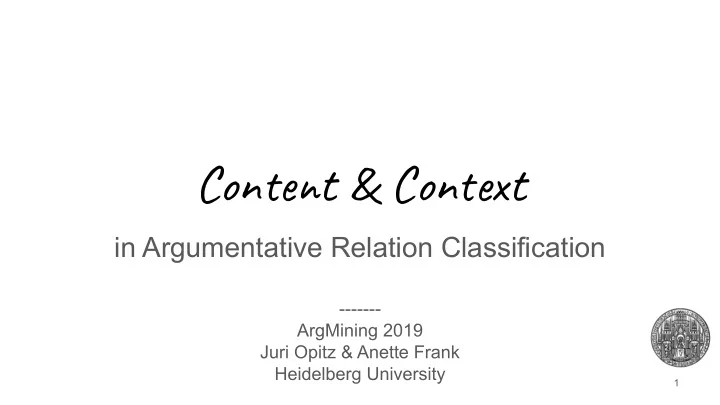

Content & Context in Argumentative Relation Classification ------- ArgMining 2019 Juri Opitz & Anette Frank Heidelberg University 1
Argumentative Relation Classification Marijuana should be legalized. “con” “pro” Legalizing marijuana can increase use by teens, with harmful results. “ attack ” However, Admittedly, Legalization allows the government to set age-restrictions on buyers. On the other hand, ... 2
Intermediate insight ● in some cases, inspection of shallow discourse clues can help predict argumentative relations with high accuracy 3
single -doc (....) AU-1 Moreover , AU-2 AU-2 supports AU-1 (....) multi- doc (....) AU-1 (....) AU-2 supports AU-1 (....) Moreover, AU-2 (....) 4
Research questions ● we want to investigate to what extent systems rely on shallow discourse clues ● where do we stand in content-based argumentative relation classification? ○ necessary for large scale cross-document argumentative relation mining ■ argumentative units for many debates can be mined from millions of documents scattered across the www ■ to assess relations between them we cannot rely on discourse clues but need systems which learn the content/meaning of argumentative units 5
Methodology 1. we replicate a competitive argumentative relation classifier: SVM (Stab and Gurevych, 2017) with i. discourse features ii. sentiment features iii. bag-of-word features iv. bag-of-production-rule features v. GloVe features vi. structural features 2. we extract these features from different spans a. features extracted from the argumentative unit span (“content”) b. features extracted from the unit’s embedding context (“context”) c. features extracted from both (“full-access”) 6
Data ● 402 Student essays (Stab and Gurevych, 2017) ● annotated with argumentative units and more than 3,000 relations ● class distribution: ca. 10% ‘attack’, ca. 90% ‘support’ ● annotated unit spans correspond to argumentative clauses ○ “ On the one hand , [AU: Legalization can increase use by teens, with harmful effects ]” “context features” “content features” “full access” 7
AU-2 CTX AU-1 CTX AU-2 AU-1 8
F1 Results: Attack vs. Support 14.5 pp 20.2 pp majority 9
F1 Results: Attack vs. Support vs. Neither 11.5 pp 15.9 pp 24.9 pp majority 10
Is everything lost for ? ● No! ○ still outperforms majority baseline by a good margin ■ +9.5 pp. macro F1 in support vs. attack ■ +10.5 pp. macro F1 in support attack vs. neither 11
Cross document potential of , and To investigate, how the three systems port to a cross document scenario, we conduct two simulation studies : ● random context : we shuffle the contexts of testing instances to simulate porting to open world where AUs may appear in arbitrary contexts ● no context: we mask the contexts of testing instances for all three systems 12
No-context “ On the one hand , [AU: Legalization can increase use by teens, with harmful <MASK> effects ]” 13
Randomized context “ On the one hand , [AU: Legalization can increase use by teens, with harmful Moreover, However, Therefore, effects ]” 14
Macro F1 Results “ bar > 0 : content-based is better” 15
Results ● we see the reverse picture: ○ models which access context (full-feature model and context-only model) fall behind the content-based system Context can be exploited by systems in single-document contexts but can lead to Problem confusion when discourse markers are missing or cannot be trusted (cross-document) Develop content-based Context-focused systems systems for are not safe for porting to Recommendation Insight cross-document scenarios cross-document scenarios 16
Take-Aways We have shown that ● shallow discourse clues are very strong indicators for argumentative relations ● a very naive system that only sees context can strongly outperform a system which sees the content and also outperforms a system which sees everything Good scores may not reflect capacity to model argumentative content Insight 1 Argumentative relation classification needs better modeling of content Insight 2 17
Conclusions Need work towards content-based argumentative relation classification ○ to address large scale argumentative relation mining across document boundaries ○ Student essay data can serve as a first benchmark ■ task: predict relations based on the content of argumentative units, mask context ○ Our results may serve as a baseline 18
Thank you for your attention! 19
Recommend
More recommend